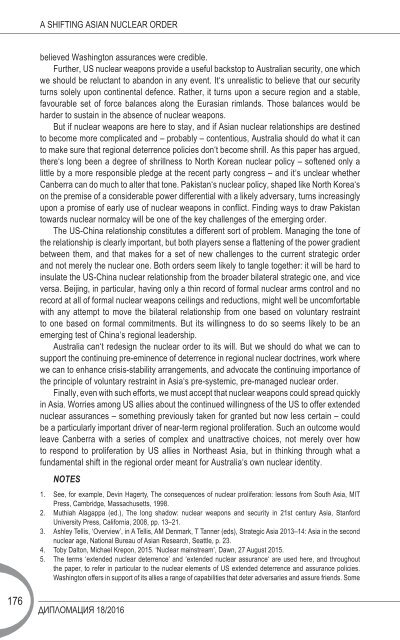DIPLOMACY ДИПЛОМАЦИЯ
2kGfdFv
2kGfdFv
Create successful ePaper yourself
Turn your PDF publications into a flip-book with our unique Google optimized e-Paper software.
A SHIFTING ASIAN NUCLEAR ORDER<br />
believed Washington assurances were credible.<br />
Further, US nuclear weapons provide a useful backstop to Australian security, one which<br />
we should be reluctant to abandon in any event. It’s unrealistic to believe that our security<br />
turns solely upon continental defence. Rather, it turns upon a secure region and a stable,<br />
favourable set of force balances along the Eurasian rimlands. Those balances would be<br />
harder to sustain in the absence of nuclear weapons.<br />
But if nuclear weapons are here to stay, and if Asian nuclear relationships are destined<br />
to become more complicated and – probably – contentious, Australia should do what it can<br />
to make sure that regional deterrence policies don’t become shrill. As this paper has argued,<br />
there’s long been a degree of shrillness to North Korean nuclear policy – softened only a<br />
little by a more responsible pledge at the recent party congress – and it’s unclear whether<br />
Canberra can do much to alter that tone. Pakistan’s nuclear policy, shaped like North Korea’s<br />
on the premise of a considerable power differential with a likely adversary, turns increasingly<br />
upon a promise of early use of nuclear weapons in conflict. Finding ways to draw Pakistan<br />
towards nuclear normalcy will be one of the key challenges of the emerging order.<br />
The US-China relationship constitutes a different sort of problem. Managing the tone of<br />
the relationship is clearly important, but both players sense a flattening of the power gradient<br />
between them, and that makes for a set of new challenges to the current strategic order<br />
and not merely the nuclear one. Both orders seem likely to tangle together: it will be hard to<br />
insulate the US-China nuclear relationship from the broader bilateral strategic one, and vice<br />
versa. Beijing, in particular, having only a thin record of formal nuclear arms control and no<br />
record at all of formal nuclear weapons ceilings and reductions, might well be uncomfortable<br />
with any attempt to move the bilateral relationship from one based on voluntary restraint<br />
to one based on formal commitments. But its willingness to do so seems likely to be an<br />
emerging test of China’s regional leadership.<br />
Australia can’t redesign the nuclear order to its will. But we should do what we can to<br />
support the continuing pre-eminence of deterrence in regional nuclear doctrines, work where<br />
we can to enhance crisis-stability arrangements, and advocate the continuing importance of<br />
the principle of voluntary restraint in Asia’s pre-systemic, pre-managed nuclear order.<br />
Finally, even with such efforts, we must accept that nuclear weapons could spread quickly<br />
in Asia. Worries among US allies about the continued willingness of the US to offer extended<br />
nuclear assurances – something previously taken for granted but now less certain – could<br />
be a particularly important driver of near-term regional proliferation. Such an outcome would<br />
leave Canberra with a series of complex and unattractive choices, not merely over how<br />
to respond to proliferation by US allies in Northeast Asia, but in thinking through what a<br />
fundamental shift in the regional order meant for Australia’s own nuclear identity.<br />
NOTES<br />
1. See, for example, Devin Hagerty, The consequences of nuclear proliferation: lessons from South Asia, MIT<br />
Press, Cambridge, Massachusetts, 1998.<br />
2. Muthiah Alagappa (ed.), The long shadow: nuclear weapons and security in 21st century Asia, Stanford<br />
University Press, California, 2008, pp. 13–21.<br />
3. Ashley Tellis, ‘Overview’, in A Tellis, AM Denmark, T Tanner (eds), Strategic Asia 2013–14: Asia in the second<br />
nuclear age, National Bureau of Asian Research, Seattle, p. 23.<br />
4. Toby Dalton, Michael Krepon, 2015. ‘Nuclear mainstream’, Dawn, 27 August 2015.<br />
5. The terms ‘extended nuclear deterrence’ and ‘extended nuclear assurance‘ are used here, and throughout<br />
the paper, to refer in particular to the nuclear elements of US extended deterrence and assurance policies.<br />
Washington offers in support of its allies a range of capabilities that deter adversaries and assure friends. Some<br />
176<br />
<strong>ДИПЛОМАЦИЯ</strong> 18/2016


